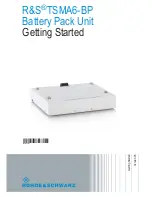
CAUTION!
3 stage charging is recommended for charging stand-alone unloaded batteries(there is no load
connected to the battery when it is being charged).
If a load is also connected simultaneously, a part of the charger‘s output current will be
diverted to this load. Thus, the charger may remain locked in the ”Boost or Absorption Mode“
if the current drawn by the load is more than the preset value of threshold current determining
change over between the Boost and Float Stages. This will lead to overcharging and loss of
electrolyte.
For charging a battery when a load is also connected simultaneously, the “Boost or Absorption
Stage“ is required to be disabled. Select ”Battery with Load“ using the Dip switch. See details
under “powering other DC loads“ at page 10.
PROTECTIONS
The charger has the following protections:
Short Circuit Shut Down
In case of a short circuit on the output side, the charger will shut down. The red LED will
switch off. The charger will automatically recover once the short circuit condition is removed.
OverloadCurrentLimiting
The current drawn by the load is automatically limited to a maximum of 15A for SEC-1215E /
SEC-2415E and 30A for SEC-1230E. If the load tries to draw a higher current than these limits,
the output voltage of the unit will start to drop. The unit will automatically recover when the
overload condition is removed.
Reverse Battery Connection Cut Off
The output is internally fused on the DC side. In case, the polarity of the battery connection is
reversed, the fuse(s) will blow. The red LED will switch off. The fuse(s) will be required to be
replaced for the unit to function again.
Thermal Overload Shutdown
CAUTION: Keep the charger in a well ventilated, cool and open area. Do not block the vent holes
on the sides or the discharge openings of the cooling fan.
SEC-1215E is cooled by convection and does not have any thermal overload shut down.
SEC-1230E and SEC-2415E are cooled by convection and in addition, have a temperature
controlled fan for forced air cooling. Two temperature sensors mounted on the power transformer
control the switching of the fan and over temperature shut down. The fan will be switched on by
the first temperature sensor when the power transformer reaches 70 degrees C. HENCE, AT
LOWER LOADS, THE FAN MAY NOT CUT IN AND WILL BE OFF. THIS IS NORMAL.
In case the fan fails or if the cooling is not adequate, the second temperature sensor will shut
down the unit if the power transformer reaches 100 degrees C. The red LED will switch off.
The unit will automatically recover on removal of thermal overload condition.
5


































